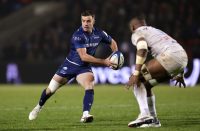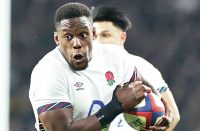 Little more than a week ago Stuart Lancaster called the next 12 months a “defining year” for his team. The England head coach was, of course, looking at the countdown to the 2015 World Cup – and his assessment was on the mark.
Little more than a week ago Stuart Lancaster called the next 12 months a “defining year” for his team. The England head coach was, of course, looking at the countdown to the 2015 World Cup – and his assessment was on the mark.
The next year is crucial to England’s development into a squad capable of winning the World Cup, as opposed to being gallant also-rans. At the moment, however, the tournament hosts are in also-ran territory, notwithstanding the importance of the victory over pool rivals Australia last weekend.
It was a match in which the result was more important than the performance because England desperately needed a win to restore some confidence and momentum after being blown away by Wales in the Six Nations decider seven months ago.
Having achieved victory over the Wallabies, Lancaster and his coaching team were faced with one of those T-junction moments when it came to which way to go against Argentina.
They could turn left to the safety of the 23 that had fashioned a win from an unpromising half-time predicament against Australia. Or they could turn right, and follow the Yellow Brick Road by selecting players who might have the cut and thrust to lift Lancaster’s solid but uninspired front rank into becoming World Cup contenders.
Given that the England head coach still does not know his best combinations there was no better time to take the right turn than a home game against Argentina. The Pumas are not to be taken lightly, but their battering in the Southern Hemisphere Rugby Championship means that England had some leeway in which to make judicious experiments to kick-start their attack and still emerge with a win.
Changing an entire front row does not tick the attacking box, and it is a great pity that the one change Lancaster appeared ready to make – bringing in Christian Wade for Chris Ashton – was thwarted by the Wasps flyer’s hamstring strain.
However, he should not have allowed that to prevent him from spinning the selection door far enough to change most of a backline that did not fire against Australia.
 There was a strong case to be made for Lancaster making it clear to the squad before the start of the autumn series that in the first two games he would field different combinations to determine his best line-up for the challenge against New Zealand in the third and final Test.
There was a strong case to be made for Lancaster making it clear to the squad before the start of the autumn series that in the first two games he would field different combinations to determine his best line-up for the challenge against New Zealand in the third and final Test.
If that had happened, Billy Twelvetrees, Joel Tomkins and Chris Ashton – all of whom failed to shine against Australia – could have been dropped without any lasting damage to self-esteem or confidence.
The same could have applied to Owen Farrell, who, despite a gutsy showing at fly-half, showed limitations by playing too deep and failing to give England’s attacking line cohesion.
With Farrell moved to the bench against Argentina, Lancaster could have given Freddie Burns a true test at No.10. Other new options could have involved giving Luther Burrell or Kyle Eastmond a blast at inside centre, and picking from Jonny May, Henry Trinder or Jonathan Joseph at outside centre, while handing May or even Charlie Sharples the wing slot vacated by Ashton – providing Lancaster was allowed to call up another wing following injury to Yarde and Wade.
My preference would have been Burns 10, Burrell 12, May 13, and Sharples 14, to join Mike Brown and Ben Foden in using their combination of pace and footwork to attack the Pumas.
Instead, Lancaster will be forced to wait for a combination of injury or defeat into forcing his hand to make significant changes, rather than doing it out of choice.
Even more controversially, he could have benched Chris Robshaw against Argentina, made Tom Wood captain for the day, and given Matt Kvesic a chance to press his claims at No.7.
It is unlikely that the 2014 Six Nations will give Lancaster many opportunities to experiment with his line-up, and the three-Test summer tour of New Zealand is not the time to field untried combinations.
By being bold against Argentina, the England head coach could have established who his best combinations were to take on this season’s undefeated All Blacks at Twickenham on Saturday in the biggest Test of the autumn.
Instead, by taking a more conservative path and retaining most of the players who faced Australia against Argentina, Lancaster will have only half the picture.
3 Comments
Leave a Comment
You must be logged in to post a comment.























I’m not sure who is picking the backs for England. In my opinion, despite the hype, Farrell is not a number 10 (proved by the fact that he is not first choice at Sarries when Hodgson is fit). Not sure why people are so anti Flood who is an outright Fly Half. My choice for the New Zealand game would have been Flood at 10 Farrell at 12 and Twelvetrees at 13. But then my dad is not an England coach is he!
Can’t really agree with much of the above as I’m not sure what else SL can do. Burns has not had a good season so far and at times Gloucester have looked better with 36 at FH. Burrell for 36 is a tight call but it’s 36’s shirt and Burrell has only really come to form this season. The game vs Aus was 36s worst performance in white so far. Ashton has had a good season with Sarries but is not the player he was. But with no Wade or Yarde the cupboard is quite bare. Much like Burns Eastmond has not set the world alight.
In truth mist of us know 36& Manu is the ideal midfield Wade, Yarde are probably the best wings Brown of Fodes at FB. Farrell has been the form fly half so far this season and Dickson is the form 9 and Youngs ability means he get the bench. Flood is there as he can cover centre teats have proved Farrell can’t do it at this level.
Based on that not sure what more SL can do if there was an option at outside centre as that’s an issue but no one is shouting to be picked and Tomkins has still only had 2 caps bit early to give him the elbow.
Pingback: รับทำเว็บ WordPress